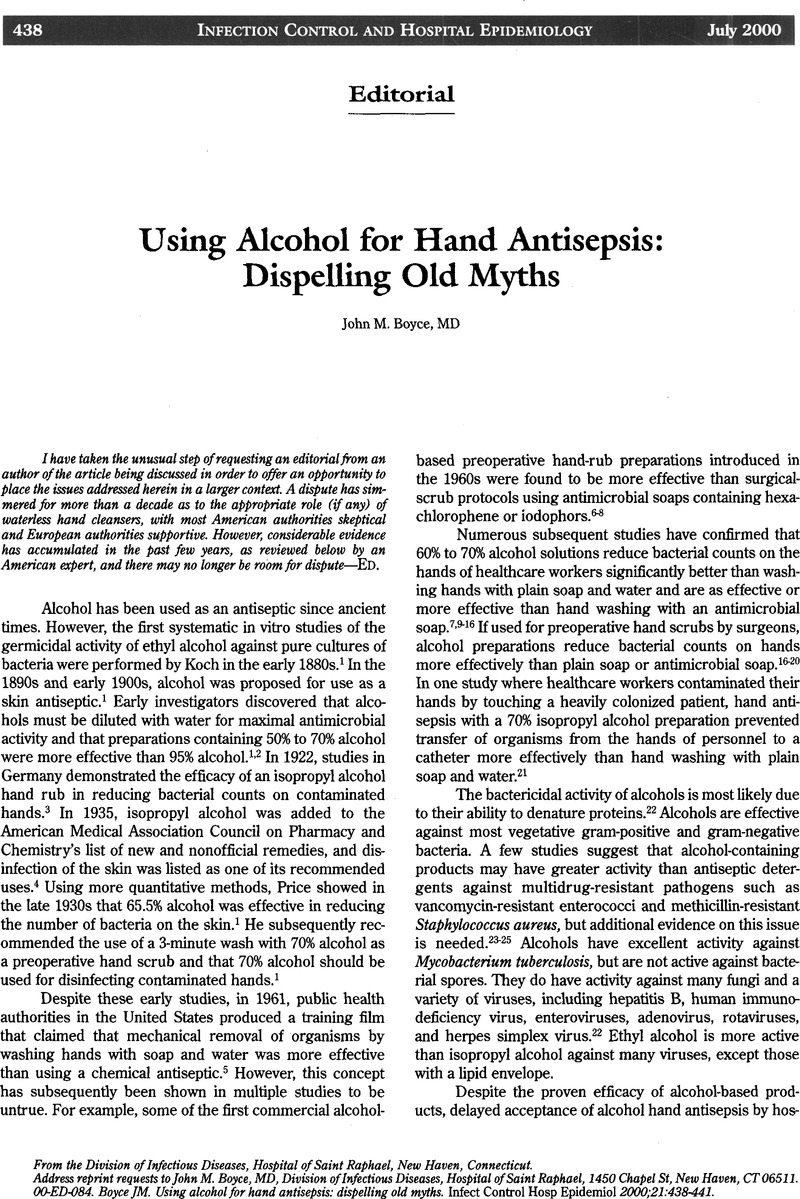Crossref Citations
This article has been cited by the following publications. This list is generated based on data provided by Crossref.
Harbarth, Stephan
Albrich, Werner
Goldmann, Donald A
and
Huebner, Johannes
2001.
Control of multiply resistant cocci: do international comparisons help?.
The Lancet Infectious Diseases,
Vol. 1,
Issue. 4,
p.
251.
Pittet, D.
2001.
Compliance with hand disinfection and its impact on hospital-acquired infections.
Journal of Hospital Infection,
Vol. 48,
Issue. ,
p.
S40.
Harbarth, Stephan
2001.
Nosocomial transmission of antibiotic-resistant microorganisms.
Current Opinion in Infectious Diseases,
Vol. 14,
Issue. 4,
p.
437.
Crosby, Cynthia T.
and
Mares, Alicia K.
2001.
Skin antisepsis: past, present, and future.
Journal of Vascular Access Devices,
Vol. 6,
Issue. 1,
p.
26.
Gruendemann, Barbara J.
and
Bjerke, Nancy B.
2001.
Is It Time for Brushless Scrubbing with an Alcohol‐based Agent?.
AORN Journal,
Vol. 74,
Issue. 6,
p.
859.
Schurink, C. A. M.
and
Bonten, M. J. M.
2001.
Infection Control in the ICU Environment.
Vol. 5,
Issue. ,
p.
213.
Kramer, A.
Bernig, T.
and
Kampf, G.
2002.
Clinical double-blind trial on the dermal tolerance and user acceptability of six alcohol-based hand disinfectants for hygienic hand disinfection.
Journal of Hospital Infection,
Vol. 51,
Issue. 2,
p.
114.
Pittet, Didier
2002.
Promotion of Hand Hygiene: Magic, Hype, or Scientific Challenge?.
Infection Control & Hospital Epidemiology,
Vol. 23,
Issue. 3,
p.
118.
HARBARTH, STEPHAN
PITTET, DIDIER
GRADY, LYNNE
ZAWACKI, ANNE
POTTER-BYNOE, GAIL
SAMORE, MATTHEW H.
and
GOLDMANN, DONALD A.
2002.
Interventional study to evaluate the impact of an alcohol-based hand gel in improving hand hygiene compliance.
The Pediatric Infectious Disease Journal,
Vol. 21,
Issue. 6,
p.
489.
Bonten, Marc J.M.
2002.
Infection in the intensive care unit: prevention strategies.
Current Opinion in Infectious Diseases,
Vol. 15,
Issue. 4,
p.
401.
Simor, Andrew E.
Bradley, Suzanne F.
Strausbaugh, Larry J.
Crossley, Kent
and
Nicolle, Lindsay E.
2002.
Clostridium difficilein Long-Term–Care Facilities for the Elderly.
Infection Control & Hospital Epidemiology,
Vol. 23,
Issue. 11,
p.
696.
Hampton, Sylvie
2002.
Skin health and hygiene.
Nursing and Residential Care,
Vol. 4,
Issue. 12,
p.
577.
Brown, Samuel M.
Lubimova, Anna V.
Khrustalyeva, Natalya M.
Shulaeva, Svetlana V.
Tekhova, Iya
Zueva, Ludmila P.
Goldmann, Donald
and
O'Rourke, Edward J.
2003.
Use of an Alcohol-Based Hand Rub and Quality Improvement Interventions to Improve Hand Hygiene in a Russian Neonatal Intensive Care Unit.
Infection Control & Hospital Epidemiology,
Vol. 24,
Issue. 3,
p.
172.
Pittet, D.
and
Harbarth, S. J.
2003.
Hände-Hygiene im Gesundheitswesen.
p.
251.
Lio, Peter A
and
Kaye, Elaine T
2004.
Topical antibacterial agents.
Infectious Disease Clinics of North America,
Vol. 18,
Issue. 3,
p.
717.
Pittet, Didier
Sax, Hugo
Hugonnet, Stéphane
and
Harbarth, Stephan
2004.
Cost Implications of Successful Hand Hygiene Promotion.
Infection Control & Hospital Epidemiology,
Vol. 25,
Issue. 3,
p.
264.
Clark, Reese
Powers, Richard
White, Robert
Bloom, Barry
Sanchez, Pablo
and
Benjamin, Daniel K
2004.
Prevention and Treatment of Nosocomial Sepsis in the NICU.
Journal of Perinatology,
Vol. 24,
Issue. 7,
p.
446.
Marshall, Caroline
Kossmann, Thomas
Wesselingh, Steve
and
Spelman, Denis
2004.
Methicillin‐resistant Staphylococcus aureus and beyond: what's new in the world of the ‘golden staph’?.
ANZ Journal of Surgery,
Vol. 74,
Issue. 6,
p.
465.
Picheansathian, Wilawan
2004.
A systematic review on the effectiveness of alcohol‐based solutions for hand hygiene.
International Journal of Nursing Practice,
Vol. 10,
Issue. 1,
p.
3.
Collins, Fiona
and
Hampton, Sylvie
2005.
Hand-washing and methicillin-resistant Staphylococcus aureus.
British Journal of Nursing,
Vol. 14,
Issue. 13,
p.
703.



